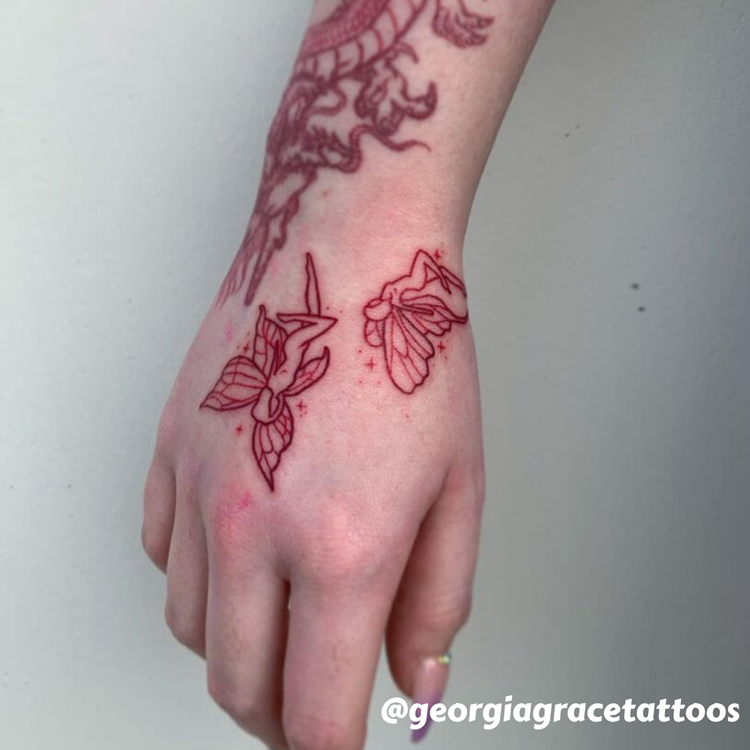The fantasy tattoo style is a vibrant and imaginative branch of tattoo artistry that draws inspiration from mythical creatures, fantastical worlds, and legendary tales. This style often incorporates intricate details, vibrant colors, and dynamic compositions to bring surreal and otherworldly visions to life on skin. Below is a comprehensive overview of its background and historical evolution:

Origins of the Fantasy Style
Fantasy tattooing finds its roots in both ancient and modern art forms that explore myth and imagination. The style is shaped by a combination of historical mythologies, literary influences, and evolving tattooing techniques:
- Ancient Mythological Art:
- The depictions of gods, heroes, and mythical creatures in ancient cultures, such as the Greek, Norse, and Celtic mythologies, heavily influence the fantasy tattoo style. Symbols like dragons, griffins, and phoenixes trace their lineage to these early mythologies.
- Ancient body modification practices, such as Polynesian and Japanese tattoos, also celebrated mythical beings, blending them with traditional patterns and lore.
- Medieval and Renaissance Influence:
- During the Middle Ages and the Renaissance, fantasy imagery gained prominence in literature, art, and storytelling. Creatures like unicorns, fairies, and gargoyles began to emerge in illuminated manuscripts and Gothic architecture.
- The flourishing of artistic styles like Romanticism, with its focus on emotional depth and mythical themes, further enriched the fantastical imagery that would later be adapted into tattooing.
- Modern Fantasy and Popular Culture:
- The modern fantasy tattoo style owes much to 20th-century literature, such as J.R.R. Tolkien’s The Lord of the Rings, C.S. Lewis’s The Chronicles of Narnia, and the works of H.P. Lovecraft. These stories introduced detailed worlds filled with elves, dwarves, magical creatures, and cosmic horrors.
- The rise of fantasy genres in films, comics, and video games in the late 20th and early 21st centuries, such as Star Wars, Game of Thrones, and Dungeons & Dragons, popularized fantastical themes and brought them into mainstream culture.

Characteristics of Fantasy Tattoos
Fantasy tattoos are highly versatile, often blending elements from multiple artistic movements and genres. Key characteristics include:
- Imaginative Subjects:
Common motifs include dragons, fairies, elves, mermaids, wizards, castles, enchanted forests, and magical symbols. These designs often reflect personal connections to stories or ideas of mythical worlds. - Vivid Colors:
Fantasy tattoos frequently employ vibrant, eye-catching color palettes to evoke magical and surreal atmospheres. Neon greens, deep blues, fiery reds, and shimmering golds are often used. - Dynamic Composition:
Designs often have a story-like quality, with intricate backgrounds and foregrounds. Techniques like shading, highlights, and blending are used to create depth and realism. - Artistic Influences:
- Realism: Some fantasy tattoos aim for a highly detailed and realistic look, akin to fine art paintings.
- Illustrative: Line-heavy, comic-style designs may mimic graphic novels or animated fantasy worlds.
- Watercolor: Abstract, fluid forms may be used to create ethereal, dreamlike effects.

Notable Artists and Contributions
Several tattoo artists have gained renown for their work in the fantasy style, pushing the boundaries of what tattoo art can achieve:
- Boris Vallejo and Julie Bell (inspiration):
Though primarily painters, their iconic fantasy art has influenced tattoo designs worldwide. - Filip Leu:
Known for blending fantasy elements with traditional Japanese tattoo motifs. - Paul Booth:
While more aligned with dark fantasy, his work showcases highly detailed creatures and otherworldly settings. - Stefano Alcantara:
A master of realism, he incorporates fantasy themes into his tattoos with breathtaking detail and emotion.
Cultural Impact
Fantasy tattoos resonate with individuals seeking to connect with their imagination, express their love for mythical tales, or symbolize personal journeys through allegorical imagery. The style also reflects the human fascination with escapism and the timeless appeal of worlds beyond reality.
As technology in tattooing evolves—such as the use of digital design tools and enhanced pigments—fantasy tattoos continue to grow in complexity and artistry. They remain a testament to the boundless creativity of both artists and wearers, celebrating the magic of storytelling through the medium of skin.